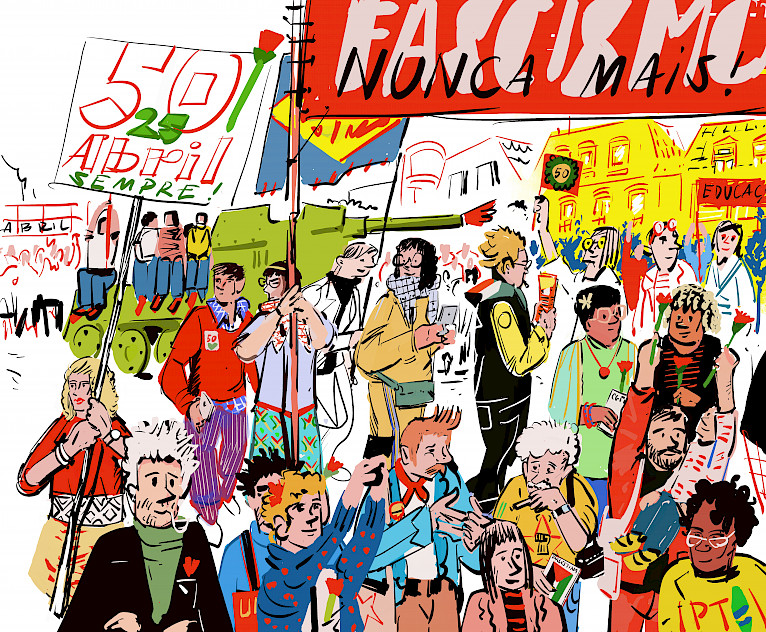Editorial by Pedro Pousada
Pedro Pousada, Director of the School of Arts of the University of Coimbra and Integrated Researcher at CEIS20, signs the editorial of the April Newsletter and presents his work as part of the celebrations of the 50th anniversary of 25 April.
Pedro Pousada, Director of the School of Arts of the University of Coimbra and Integrated Researcher at CEIS20, signs the editorial of the April Newsletter and presents his work as part of the celebrations of the 50th anniversary of 25 April.
Art Research (specifically Art Based Research, ABR) is part of the School of Arts’ training programme and already has a history of theoretical production; however, experience has shown us that artistic knowledge, which is born from know-how and falls back on that know-how, transforming, problematising and even transcending its premises, gains greater scope when it is combined with other disciplinary fields, interacting with them, learning from them and reformulating itself. In this sense, the interaction with other knowledge that enables it to operate in the new territories of mediation and technological creation, the questioning of contemporaneity from a postcolonial approach, the decolonial denaturalisation of Western iconographies and hegemonic modes of making, racial empowerment as a new ethos of plastic creation, micro-politics as an interface between the artistic act and the experience of active citizenship, and the poetics of immanence and dissidence that emerge from these themes and that have generated a new methodological and enunciative paradigm of the artistic condition, are today inescapable for art research, for research based on practice. We can think of art research as a meta-critique of artistic practice that seeks to liberate it from its commonplaces, from its illusions about what art should be, and that can only do this in a sustainable and anti-scholastic way by re-signifying the way it communicates with the disciplinary fields that are tangential or even distant from it. CEIS20 provides the interdisciplinary ecosystem in which our teachers and researchers, including myself, are able to achieve this dialogue.

Today, thanks to the interdisciplinary contribution, we can define ABR as an operation that is at the same time analytical, an operation that chooses an artistic object or process, however heteroclite and unformed it may be, and develops or proposes to develop a reflexive approach to it, in the sense of its critical and epistemological wealth. It is an operation that is at the same tome relational, placing its object in the context of other objects, repositioning its singularity and materiality in the historical space-time, testing and problematising its visual, haptic and sensory evidence. The disambiguation inherent in the scientific method does not work here, in the ABR, as the promise of a hermeneutic essentialism – the key to explaining the artistic work and its future – or of an art theory that is also capable of being an art practice, as in modernism, but as in the epistemological flow of interdisciplinarity, this method teaches the artist who investigates through practice to hesitate in the face of the performativity of their creative certainties and to share this hesitation with other knowledge. The transience and uncertainty of contemporary categories allows us to more easily consider artistic production and its historical-cultural peripheries beyond a static and stable state: a flow of images, a flow of temporalities, a flow of "practiced spaces ", a flow of experiences of appropriation, quotation, re-signification, self-discovery or reinvention, of questioning. Nevertheless, a repertoire of flows that elude the chronological succession and symbolic hierarchies (a repertoire that in a way seeks to free itself from the geopolitical aestheticisation of art history, to paraphrase W. Benjamin) and that at the same time coexists without being seduced by the syncretism of equivalences (always in the effort to de-realise the equality of practices, not in the sense of denying otherness, but in the sense that it is not possible – in line with Hal Foster and his "Against Pluralism", to be everywhere, with everywhere, with all the ways of existing and making these places. Basically, you have to make choices, take a stand, accept that contemporary art, the art of the present, of the lived (the past) and the unlived (the future, or the past that returns in the future) is like life for Baudelaire: a place of horror and ecstasy, of communion and profanation.
Pedro Pousada
